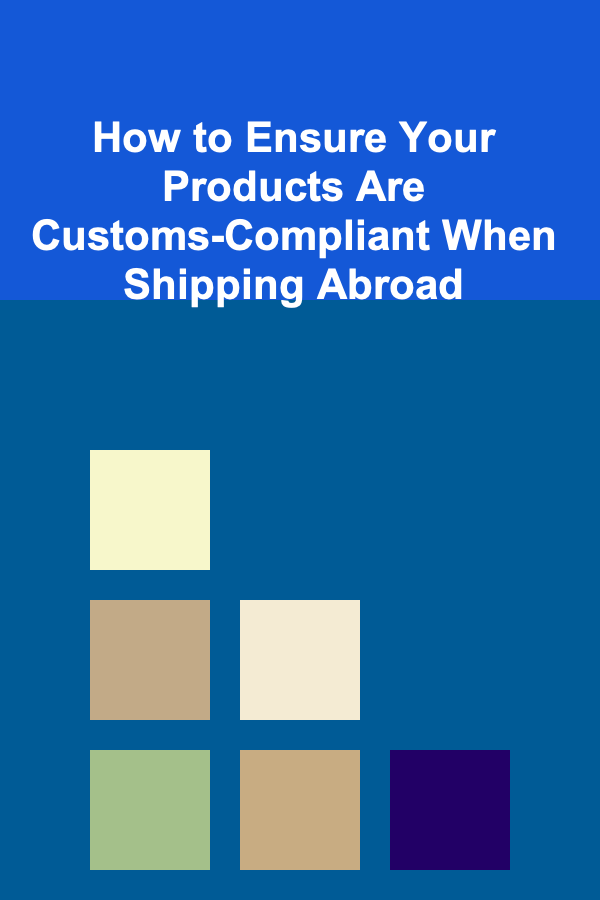
How to Ensure Your Products Are Customs-Compliant When Shipping Abroad
ebook include PDF & Audio bundle (Micro Guide)
$12.99$7.99
Limited Time Offer! Order within the next:

Shipping products internationally can be an excellent opportunity to expand your business, tap into new markets, and increase sales. However, navigating the complexities of customs compliance is essential to avoid delays, fines, or potential confiscation of goods. Each country has its own set of regulations and requirements for importing goods, and failing to meet those requirements can result in unnecessary complications that can negatively affect your international shipping.
This actionable guide will provide you with practical steps to ensure your products are customs-compliant when shipping abroad, offering insights into the process, documentation, and best practices.
Understand the Importance of Customs Compliance
Customs compliance refers to adhering to the rules and regulations established by governments to control the import and export of goods. These regulations are in place to protect national security, ensure the payment of applicable taxes and duties, and uphold international trade agreements. Non-compliance can lead to:
- Delays: Customs clearance might be delayed, causing disruption to your shipping timeline.
- Fines: You could face hefty fines for improperly declared goods or incorrect documentation.
- Confiscation of Goods: In some cases, customs authorities may seize your goods, leading to a total loss.
- Reputation Damage: Continuous non-compliance may harm your reputation with customs authorities, leading to more intense scrutiny on future shipments.
Ensuring your products meet the required standards and regulations will help your shipments clear customs without hassle and prevent these potential problems.
Research the Import Regulations of Target Countries
Before shipping any product abroad, it's crucial to thoroughly research the import regulations of the destination country. Customs regulations vary significantly from one country to another, and knowing what's required will help you avoid mistakes.
Key Areas to Research:
- Product Restrictions: Some countries prohibit the importation of certain products or have strict regulations governing their import. These may include food items, electronics, chemicals, or pharmaceuticals.
- Tariffs and Duties: Each country imposes tariffs (taxes) on imported goods. These fees are based on factors like the type of product, its value, and its country of origin. Understand the applicable tariffs for your products.
- Labeling and Packaging Requirements: Some countries have specific labeling requirements for products, such as language specifications, safety warnings, and ingredient lists. Ensure your product packaging meets these requirements to avoid issues.
- Import Licensing: Certain products may require an import license to enter a country. For example, products like alcohol, firearms, or chemicals often have licensing and permit requirements.
Tip:
Engage with local customs brokers or import experts in the destination country to help navigate these regulations effectively.
Use Harmonized System (HS) Codes for Accurate Classification
The Harmonized System (HS) Code is an internationally standardized system used to classify traded products. Every product that crosses borders must be assigned an appropriate HS Code, which helps customs authorities determine the applicable tariffs, duties, and taxes. Misclassifying your products can lead to customs delays or even penalties.
Steps for Correct HS Code Classification:
- Determine the Correct HS Code: You can find the HS Code for your product by consulting official resources like the customs website or the World Customs Organization (WCO).
- Use Online Tools: Many countries provide online tools to help businesses determine the appropriate HS Code for their products. Websites like the U.S. Customs and Border Protection (CBP) or the European Union's TARIC provide detailed resources.
- Consult with Experts: If you are unsure about the correct HS Code, it's a good idea to consult with a customs broker or international trade expert to ensure accuracy.
Tip:
Incorrect HS Codes can not only lead to fines but may also delay your shipment as customs authorities may hold your goods for further inspection.
Ensure Proper Documentation and Declarations
One of the most critical elements of customs compliance is ensuring that all required documentation is accurate, complete, and submitted on time. Missing or incomplete paperwork can delay your shipment and may even result in goods being seized.
Key Documents for International Shipping:
- Commercial Invoice: A commercial invoice includes essential details about the transaction, including product descriptions, prices, quantity, and the terms of sale. It helps customs officials assess the correct duties and taxes.
- Packing List: The packing list provides a detailed breakdown of the contents of the shipment. It's essential for customs to verify the contents of your shipment against the commercial invoice.
- Bill of Lading: This document serves as proof of the contract between the shipper and the carrier, confirming the shipment and its terms.
- Certificate of Origin: This document indicates the country where the product was manufactured or assembled. Some countries offer reduced tariffs or exemptions based on the trade agreement between the origin country and the destination country.
- Import License: If required, ensure you have the necessary import licenses for your product.
- Customs Declaration: This document provides detailed information about the goods being shipped and must be submitted to customs for processing.
Tip:
Work with a reliable freight forwarder or customs broker to ensure you have all the correct documentation for your shipment.
Calculate and Pay Duties and Taxes
Duties and taxes are one of the key components of customs compliance. Every country imposes different rates depending on the product category, value, and its country of origin. To avoid delays, it's important to calculate and pay these duties in advance.
Steps to Handle Duties and Taxes:
- Determine the Duty Rate: Use the HS Code and the customs tariff schedule to determine the duty rate for your product. The rate is often a percentage of the product's value, but it may vary by product and country.
- Ensure Accurate Valuation: The value of your goods for customs purposes should be the transaction value, which includes the cost of the goods plus any shipping and insurance fees.
- Customs Broker Assistance: A licensed customs broker can help you calculate the correct duties and taxes, ensuring compliance with all regulations.
Tip:
Always include shipping costs, insurance, and handling fees in the value of the goods, as customs duties are typically calculated based on the total landed cost.
Use a Trusted Shipping Carrier
Partnering with a reliable shipping carrier that understands the intricacies of international shipping can make the process smoother. Established carriers like FedEx, UPS, DHL, and others often provide customs clearance services, helping you ensure that your products meet the required compliance standards.
How to Choose the Right Shipping Carrier:
- Experience with Customs: Ensure the carrier has experience with customs procedures and can help guide you through the clearance process.
- Tracking and Support: Opt for carriers who offer real-time tracking and customer support to keep you informed about the status of your shipment and address any customs-related issues.
- Global Network: Choose a carrier with a wide international network that can handle shipments to the specific regions where you are conducting business.
Tip:
Some carriers also provide the option of "Delivered Duty Paid" (DDP) shipping, where they handle all customs duties and taxes on your behalf, making the process easier for both you and the recipient.
Stay Up-to-Date with Changing Regulations
Customs regulations are subject to frequent changes, and what may have been compliant yesterday might no longer be valid today. Keeping up with changing laws is crucial to staying compliant.
How to Stay Informed:
- Subscribe to Customs Updates: Many countries have official channels where they announce changes in import/export regulations. For example, the U.S. Customs and Border Protection (CBP) regularly publishes updates on trade regulations.
- Work with a Customs Broker: A licensed customs broker stays current with the latest customs regulations and can provide timely advice and updates regarding your shipments.
- Attend Trade Conferences: Participating in industry events and conferences can help you stay ahead of changes in international trade rules and build relationships with experts.
Tip:
Create a system to review your shipping processes periodically to ensure that all products are compliant with the latest rules.
Implement a Risk Management Plan
Even with the best preparation, customs clearance can sometimes be unpredictable. A risk management plan can help you address potential issues promptly and minimize disruptions to your business.
Components of a Risk Management Plan:
- Contingency Plans: Develop backup plans for potential delays or customs disputes. This might include maintaining relationships with alternative carriers or exploring other shipping routes.
- Customs Broker Partnerships: Establish a good relationship with a customs broker who can quickly help resolve issues when they arise.
- Insurance: Consider purchasing insurance that covers goods during the customs process, as well as any potential fines or fees incurred during non-compliance situations.
Tip:
Document every step of your customs clearance process. If a dispute arises, having a detailed record of your actions can help resolve the issue quickly.
Conclusion
Ensuring that your products are customs-compliant when shipping abroad requires careful planning, attention to detail, and a proactive approach to navigating the complexities of international trade regulations. By understanding import regulations, accurately classifying products, completing the correct documentation, and staying up-to-date with changes, you can avoid customs delays, fines, and other costly issues.
Customs compliance may seem like a daunting task, but by working with trusted partners, using the right tools, and consistently following best practices, you can smoothly and successfully manage the process of shipping products across borders.
Reading More From Our Other Websites
- [Paragliding Tip 101] Lightweight vs. Heavy-Duty: How to Choose the Perfect Harness for Long-Distance Flights
- [Biking 101] Top 5 Bike Gloves for Every Type of Cyclist
- [Home Pet Care 101] How to Deal with a Picky Eater Pet When Transitioning from Kitten/Puppy Food to Adult Formulations
- [Organization Tip 101] How to Organize Your Budget Around Your Values
- [Organization Tip 101] How to Utilize Leftovers in Your Meal Prep Strategy
- [Organization Tip 101] How to Organize Your Collection of DVDs or Video Games
- [Tiny Home Living Tip 101] How to Build a Tiny Home with a Retractable Roof Deck for Seasonal Outdoor Living
- [Home Cleaning 101] Best Vacuum Cleaners for Pet Hair: Top Picks for Pet Owners
- [Metal Stamping Tip 101] Sustainable Practices in CNC Metal Stamping: Reducing Waste and Energy Use
- [Personal Investment 101] How to Invest in Real Estate with Little Money

How to Bake Doughnuts (Baked and Fried)
Read More
How to Create a Schedule for Working Part-Time as a Social Media Administrator
Read More
How to Track Business and Personal Expenses Separately
Read More
How to Utilize Rolling Carts for Mobile Essential Oil Storage
Read More
What Are the Benefits of Minimalism in Home Organization?
Read More
How to Explore Quantum Computing for Logistics and Supply Chain
Read MoreOther Products

How to Bake Doughnuts (Baked and Fried)
Read More
How to Create a Schedule for Working Part-Time as a Social Media Administrator
Read More
How to Track Business and Personal Expenses Separately
Read More
How to Utilize Rolling Carts for Mobile Essential Oil Storage
Read More
What Are the Benefits of Minimalism in Home Organization?
Read More